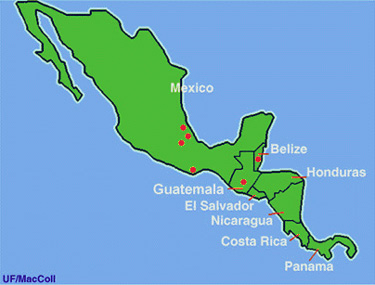
Map of distribution of M. callizona in Mexico and Central America
Metamasius callizona was described from the state of Veracruz, Mexico in 1883, with subsequent records from the department of Alta Verapaz, Guatemala and the province of Chiriquí, Panama. Its host plants were not identified to genus, though there is a questionable record from pineapple (Vaurie 1966).
In July 1992, Howard Frank and Michael Thomas visited Veracruz, Mexico, in search of M. callizona. They found it to be very uncommon, and found no potential biological control agents. Host plants in which it was found are listed 3 paragraphs below.
In June 1994, Howard Frank and Al Muzzell visited Panama, and were unable to find M. callizona in bromeliads in Chiriquí; further, though many specimens of Metamasius were housed in insect collections at the Smithsonian Tropical Research Institute, none was of M. callizona (Frank, unpublished). For these reasons, we believe that the early record of M. callizona from Panama is questionable, and that its natural range may be restricted to southern Mexico and Guatemala.
In April - September 1995, Howard Frank spent 6 months in Veracruz, Mexico, and on some weekends searched for weevils in bromeliads. Again, he found M. callizona to be very uncommon, and he also found Cactophagus validirostris and Metamasius flavopictus attacking bromeliads. He found no potential biological control agents for M. callizona.
Recent host-plant records are from the following Mexican states: Veracruz: Aechmea mexicana (Zaragoza 1974), Tillandsia deppeana, T. ehlersiana, T. heterophylla, T. streptophylla, and T. utriculata (Frank & Thomas 1994b), Catopsis sp. and Tillandsia limbata (Frank, unpublished), Oaxaca: Tillandsia roland-gosselinii (letter and specimen from Dennis Cathcart to Howard Frank), Puebla: Vriesia sp. (Zaragoza 1974).
Enormous numbers of insects are intercepted annually by USDA-APHIS inspectors at US ports and airports in shipments of plant material (Frank & McCoy 1992). Between 1973 and 1987, specimens of M. callizona were intercepted 14 times by the inspectors, on all but one occasion on Tillandsia spp., and all from Mexico (Frank & Thomas 1994b). Because inspection is made of fewer than 2% of shipments, the probability is very high that living M. callizona escaped detection and were forwarded to importers within the USA. Indeed, importers have told us of having found living specimens in shipping containers from Mexico. This evidence alone provides a very high probability that the M. callizona population which is now established in Florida came from Mexico in shipments of Tillandsia spp. One of the USDA-APHIS records identified Tillandsia tricolor as the plant in the shipping container, but most of the interception records do not identify the plants to species (Frank & Thomas 1994b).
Two ways could be used to prevent importation of such pest weevils: (1) immersion of all imported plants in appropriate chemical pesticides before shipment (though susceptibility of weevil eggs to such chemicals is unknown); (2) restriction of imported bromeliads to seed. We urge that anyone who imports bromeliads use one of these methods. Although tremendous damage is now being done in Florida by M. callizona, the situation could be worsened if yet other species of bromeliad-eating weevils arrive. In our opinion, anyone who does not use one of these methods is irresponsible and should be liable to legal action.

revised 9/00